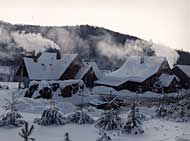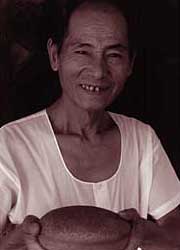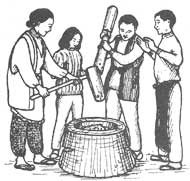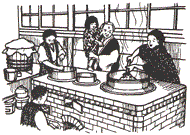|
|
|
Our Story |
|
 |
 |
|
South River Farm, home of South River Miso. |
|

Christian and Gaella Elwell |
A conversation with the founders and owners of South River Miso,
Christian and Gaella Elwell.
Part 1
CHRISTIAN: The first, delicate outlines of South River Miso first appeared
as a rough sketch I made on a paper napkin at an Irish pub in Brookline
Village, Massachusetts, in 1977. At that time, Gaella and I were living at
the home of Michio and Aveline Kushi, world-renowned teachers and leaders of
the macrobiotic movement. I imagined a way of life I wanted to live on the
land in New England: a meaningful, sustainable life, with direct connection
to the real sources of our life and being in Spirit, Nature, community, and
culture. I thought miso making, as a positive expression of right
livelihood, would lend itself to this vision. |
|

Noburu Muramoto (1920-1995), macrobiotic healer and our
teacher in the art
of miso making.
|
The following year we had the opportunity to live at
Asunaro, Naburo Muramoto’s School of Oriental Medicine and Traditional
Fermented Foods in Glen Ellen, California. Sensei Muramoto was an innovative
craftsman with all kinds of traditional foods, herbal, and other natural
remedies. He authored the popular manual for alternative health care,
Healing Ourselves. For three months we made batch after small batch of many
different kinds of miso under Mr. Muramoto’s direct supervision. From the
very beginning, our training was within the context of the healing arts, and
we have always revered miso for its potential as a medicinal food.
GAELLA: Sensei Muramoto was a small man with big plans and bundles of
ingenuity. He tackled the running of the school, as well as his herbal tea
company, worked in the gardens and streams, healed the sick, studied and
wrote daily. Amidst it all, he kept one eye on the many jars of bubbling,
homemade saké lining his tiny living room. Once he tried to fix an old used
refrigerator and laughed heartily at himself when it put out hot air instead
of cold! I loved the smell of his little koji room [koji is the fermented
grain used in miso making]. Its scent reminded me of pungent New England
apples stored for the winter. My favorite food experiment was his peanut
miso…delicious! |
|
 |
CHRISTIAN: While living at Asunaro we met Thom Leonard, who, soon after,
founded the Ohio Miso Company with Dick Kluding. In January 1980, when their
original partnership was unable to continue, Thom approached us to see if we
would like to carry on with the business. We said "yes!", and, in November
of 1980, I went with a friend to Ohio, packed equipment, vats, and
everything else, plus 13 tons of miso into one huge semi-trailer and brought
it all to South River Farm, our new homestead in Conway, Mass., named after
the beautiful river that runs through the property. In January 1981, we
changed our newly acquired company’s name to South River Miso.
GAELLA: That first winter we packed out those 13 tons of miso from our
unheated barn and moved it across the South River with draft horses to meet
the UPS truck. We found that the high salt content kept the miso from
freezing, but not our hands!
|
|

Making Inaka Miso
The Book of Miso |
CHRISTIAN: In Japan there is a name for miso made in the centuries-old
farmhouse tradition: inaka miso. It is miso that is made by hand in
necessarily small batches by food artisans and farming families in their
village shops and homes or by Buddhist monks in their religious communities.
The miso was made after the harvest season in the cold months of the year
over wood-fired cauldrons. After cooking for many hours, the beans were
gently mashed under foot like the wine grape and mixed together with the
fragrant, whole grain koji. The raw miso was then placed in great wooden
vats or smaller kegs in the home, where it "gathered time", or cosmic ki
energy, transforming with the seasons. After one to three years, depending
on the variety, the miso was ready for harvest. On the appropriate day,
friends and family would gather together for the opening of the vat,
blessing the new vintage full of life-essential nourishment, and daily
medicine power. Until quite recently in Japanese history inaka miso was the
only kind of miso made, the only kind of miso known. Now, in Japan, it is
the rare treasure of a time gone by when every village and even individual
families made their own favorite variety of miso and each region was known
for its most popular type. |
|
 |
We decided that if we were going to be so bold as to make miso in New
England, we wanted to do it in the inaka tradition. In 1981, We hired Jerry
Sawma, a local, master timber-frame builder, and constructed a post-and-beam
shop out of native timber. The design is based on a small traditional miso
shop and features a massive masonry stove (built by Albie Barden of Maine)
with a wood fired cauldron with which we steam the grains, boil the beans,
and also, heat the shop.
TO BE CONTINUED LATER WITH Part 2 |
|
|